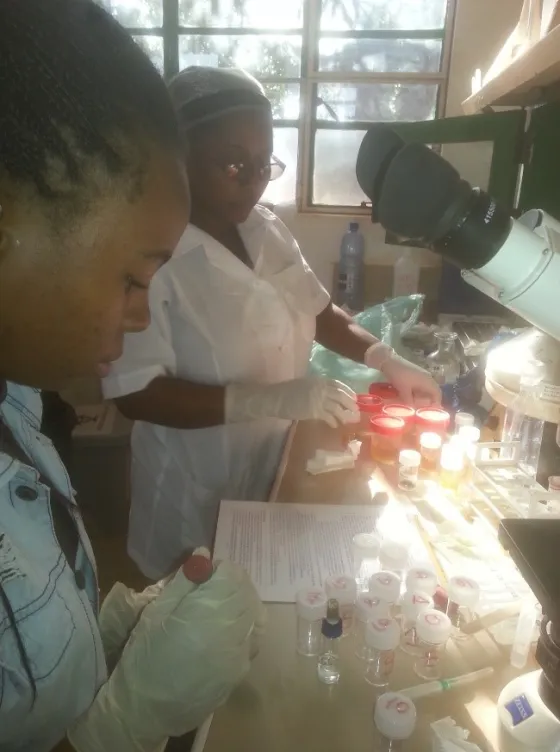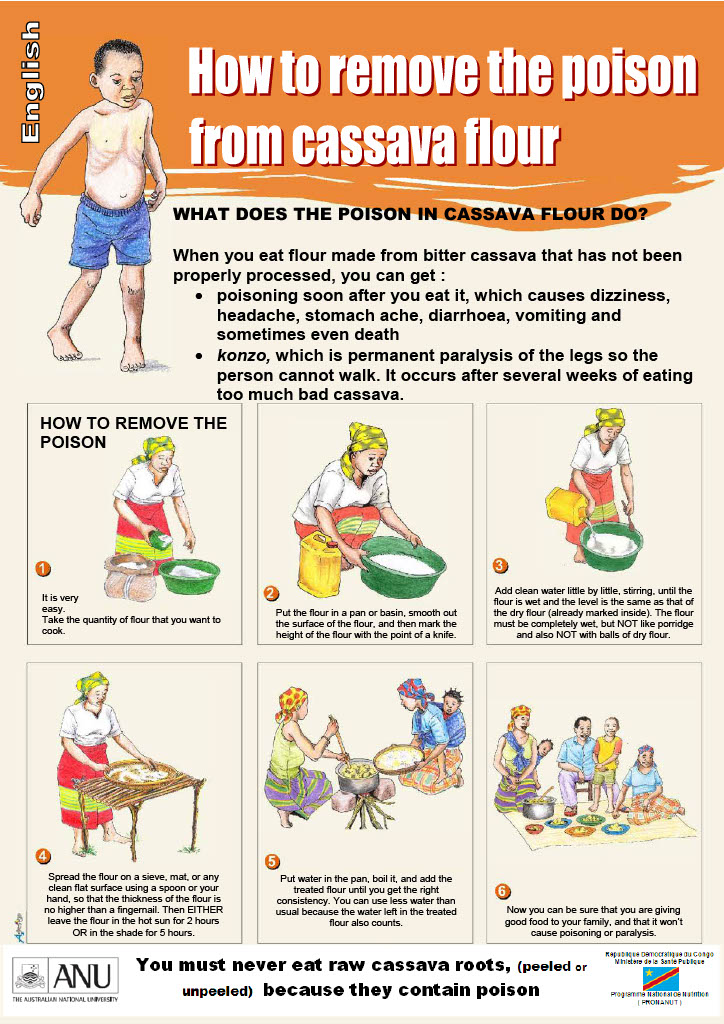Kits & Posters
Kits

In 1995 we developed a new quantitative method of determination of cyanide, based on the well-known qualitative picrate paper test for cyanide. This has now been translated into 16 languages. The method can be used as a simple field test with a colour chart with 10 shades of colour from 0-800 mg HCN equivalents/kg fresh weight = ppm, and/or quantitatively by elution of the colour from the paper in water and measurement of the absorbance at 510 nm in a spectrophotometer (see Publications Nos. 17 and 19). The quantitative method was compared over a wide range of cyanogenic plants and foods with the acid hydrolysis method and found to be just as accurate (see Publications No. 15). Linamarin and linamase were isolated for use in the kits (see Publications Nos. 23 and 24). We have increased tenfold the sensitivity of the picrate method by using a smaller picrate paper and elution volume and use of micro cells in the spectrophotometer (see Publications No. 10).
Kits A and B2 were developed for determination of total cyanide in cassava roots and cassava products and each kit allows 100 analyses to be made. Subsequently, kits were developed to allow analysis of cyanogenic leaves (Kit E), bamboo shoots (Kit F) and flax seed meal (Kit G).
Ingested cyanide is converted to thiocyanate in the body and is removed in the urine, thus a urinary thiocyanate determination gives a measure of cyanide intake over the preceding days. Kit D1 was developed for the determination of thiocyanate in urine (see Publications No. 18), which was successfully trialled in Mozambique in 1999 (see Publications No. 16).
The Australian Centre for International Agricultural Research (ACIAR) funded the research and development of kits A to G and supply of the kits, free of charge, to agriculturalists and health workers in developing countries. This funding ceased in 2004 but the free offer is still available although due to demand we can only send one 1 kit. Kits A, B2, D1, E, F and G (100 tests) are available for purchase by contacting the Konzo Prevention Fund on konzo@anu.edu.au. Nearly 700 free and 850+ purchased kits have now been supplied to workers in over 40 countries.
Protocols
- Kit A: Determination of total cyanide in cassava roots. Protocol A (pdf)
- Kit B2: Determination of total cyanide in cassava products (flour, gari, etc.) Protocol B2 (pdf)
- Kit D1: Determination of thiocyanate in urine. Protocol D1 (pdf)
- Kit E: Determination of total cyanide in leaves. Protocol E (pdf)
- Kit F: Determination of total cyanide in bamboo shoots. Protocol F (pdf)
- Kit G: Determination of total cyanide in flax seed (linseed). Protocol G (pdf)
- Protocols for Kits B2 and D1 are available in French and Portuguese on request.
Price
AUD $750.00 Kits A, B2, D1, E, F and G (100 tests/kit), includes delivery.
Posters
A coloured poster which shows how to use the wetting method to remove cyanide from cassava flour was originally produced by Dr Dulce Nhassico in Portuguese. This was translated into English and other languages. It has since been modified twice to include cyanide poisoning and also another treatment option of standing for two hours in the sun to remove hydrogen cyanide from the wet flour. The text has been translated into many different languages (we wish to thank our many translators), and the words have been placed into the pictures by Mr Ian Denton. These laminated posters in 16 languages (a few have not been updated with the 2hr in the sun option) are available free of charge to be distributed in rural areas, particularly those where konzo and cyanide poisoning occur.
Those marked * have not been updated for the 2hr in the sun modification.
Poster Amharic
Poster Ateso*
Poster Banvele
Poster Chichewa
Poster English
Poster English Gari
Poster French
Poster Hausa*
Poster Kifuliru
Poster Kiswahili
Poster Kiyaka
Poster Macua*
Poster Maka
Poster Portuguese (Brochure)
Poster Shona
Poster Spanish
Poster Tshiluba

